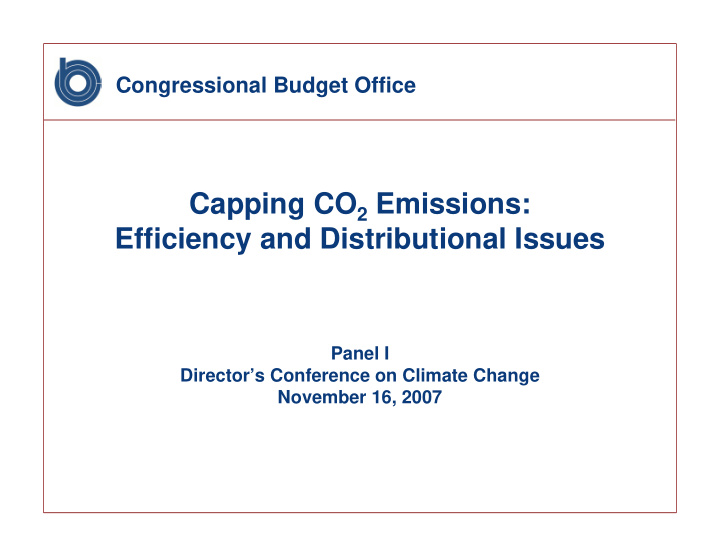



Congressional Budget Office Capping CO 2 Emissions: Efficiency and Distributional Issues Panel I Director’s Conference on Climate Change November 16, 2007
Cap-and-Trade Basics What is a Cap-and-Trade Program? � Policymakers set overall cap on carbon emissions � Government requires firms to hold rights (allowances) for their emissions. Requirement could be placed on: – Producers and importers of fossil fuels (Upstream design) – Users of fossil fuels (Downstream design) � Government allocates allowances. Key decision: Should allowances be sold or distributed for free? – If they are sold, the government decides how to use revenues it receives � Firms may buy and sell allowances among themselves
Potential Effects of a CO 2 Cap-and-Trade Program � Reduce environmental and economic damages in the future � Impose costs on the economy in the near term. Cap limits fossil fuel use and raises prices: – Consumers incur costs to reduce their use – Some shareholders face a decrease in stock values � Affected industries include coal (largest), petroleum refining, oil and gas suppliers, utilities � Losses widely dispersed: Small losses for large number of households – Some workers may lose their jobs, particularly in coal sector � Losses concentrated: Small number of households incur large losses – Price increases aggravate distortions from taxes on capital and labor � That indirect cost could exceed direct cost in fossil fuel markets
Potential Effects of CO 2 a Cap-and-Trade Program (Continued) � Transfer income from bearers of allowance cost to recipients of allowance value – Market forces would determine who bore the allowance cost � Primarily borne by consumers in form of price increases – Policymakers would determine who received the allowance value � Selling allowances: Government captures value (As it would with a tax) ◦ Ultimate beneficiaries depend on decisions about how to use the revenues � Distributing allowances for free: Receiving firms capture value � Allocation decision could affect total cost to economy
Amount of Income Transferred (Allowance Value) Likely to Be Much Larger Under a Program Capping CO 2 Than SO 2 Billions of 2006 dollars 300 250 200 150 100 50 0 Approximate Value of SO Approximate Value of CO Allowances in 2 2 Allowances in 2005 2020 Under Legislative Proposals
Presenters Examine Different Pieces of the Puzzle � Lawrence Goulder examines: – Net loses to shareholders by industry – Effect of allowance allocations on economywide cost � Dallas Burtraw examines: – Potential complications should policymakers choose to give allowances to electricity generators – Industry-level versus firm-level losses � Gilbert Metcalf examines : – Net effect of cap-induced price increases and allowance allocation on households � Dick Goettle examines: – Household-level effects and economywide cost using a model that assumes full employment of labor and capital
Recommend
More recommend